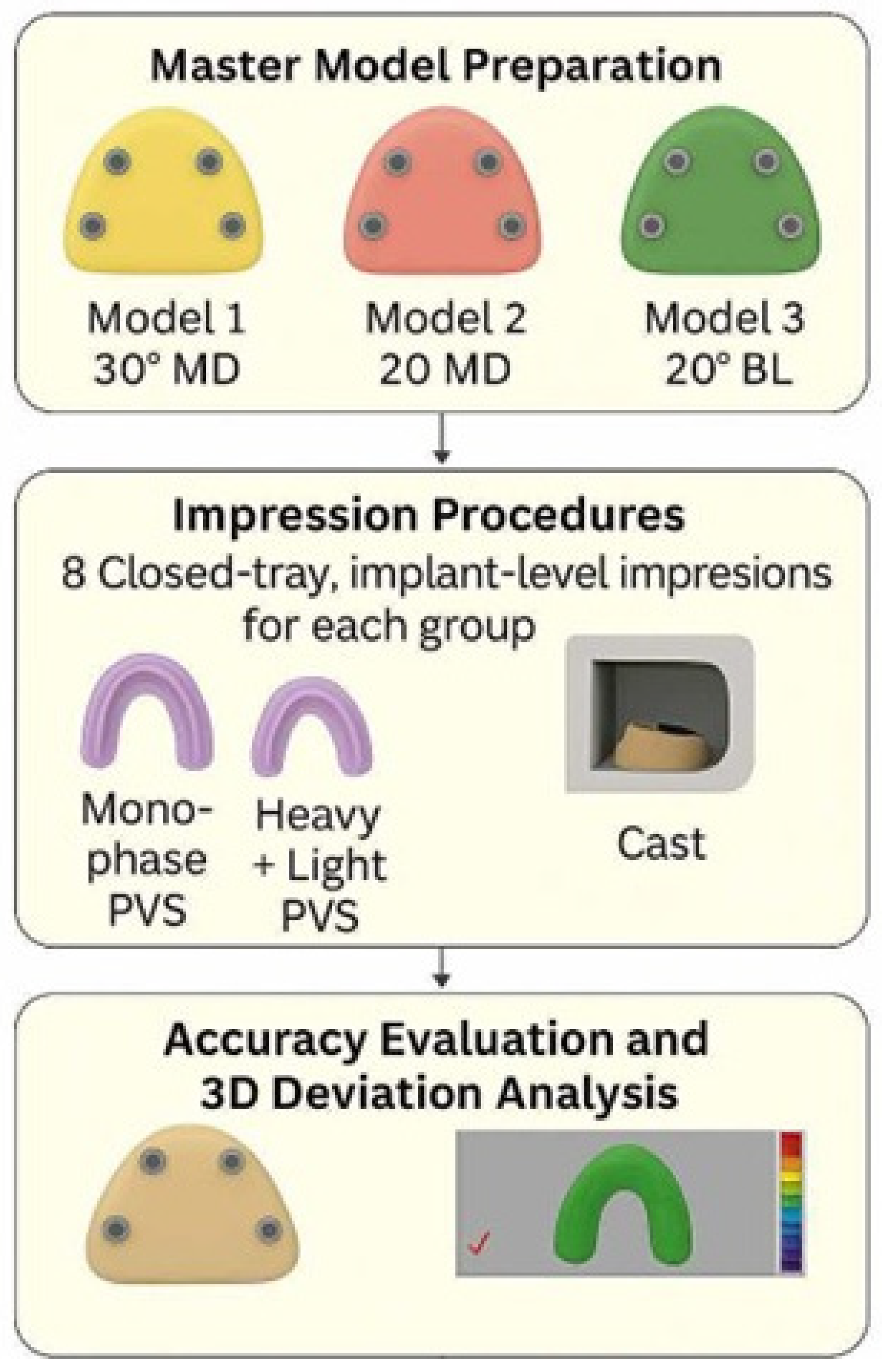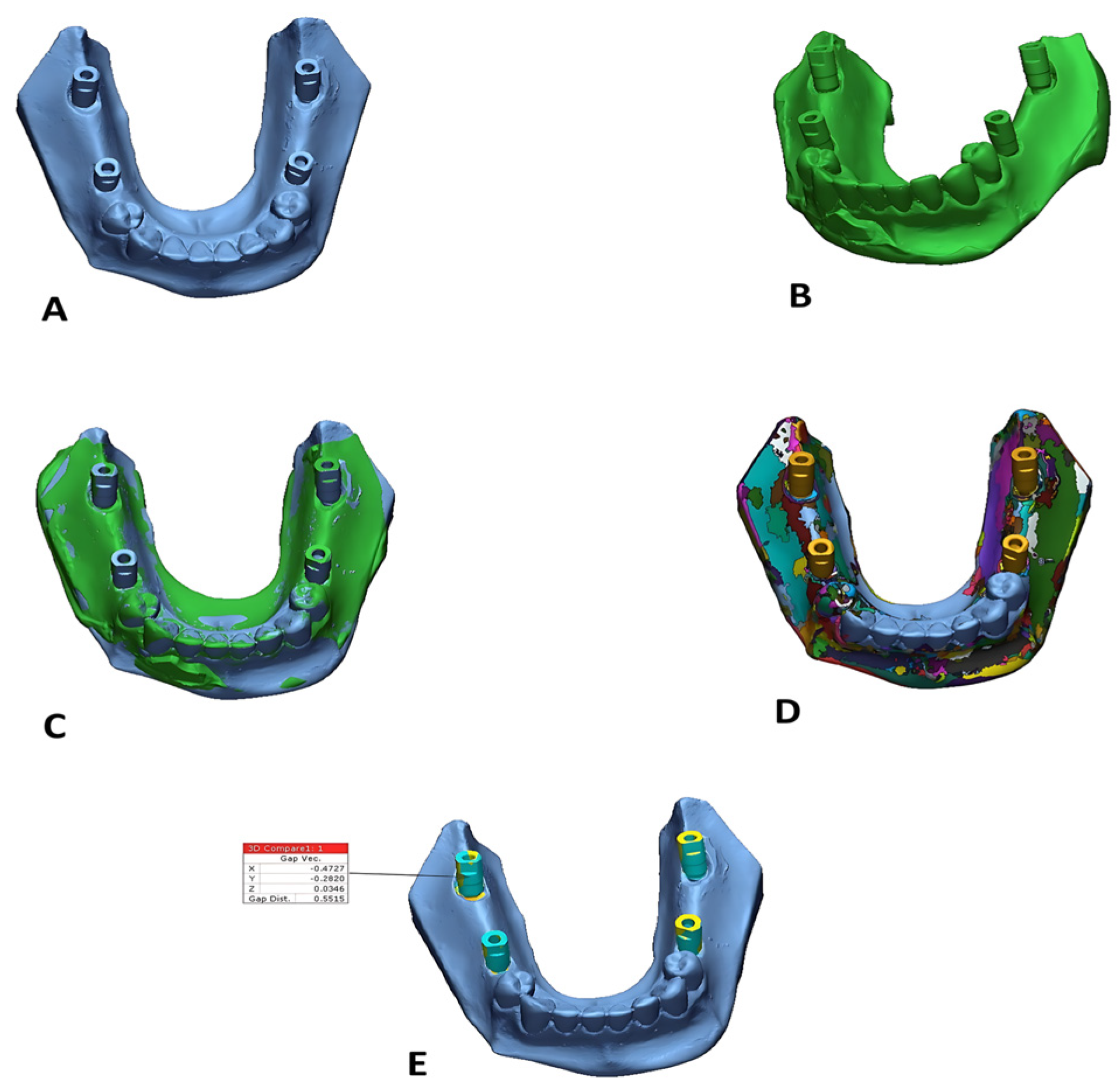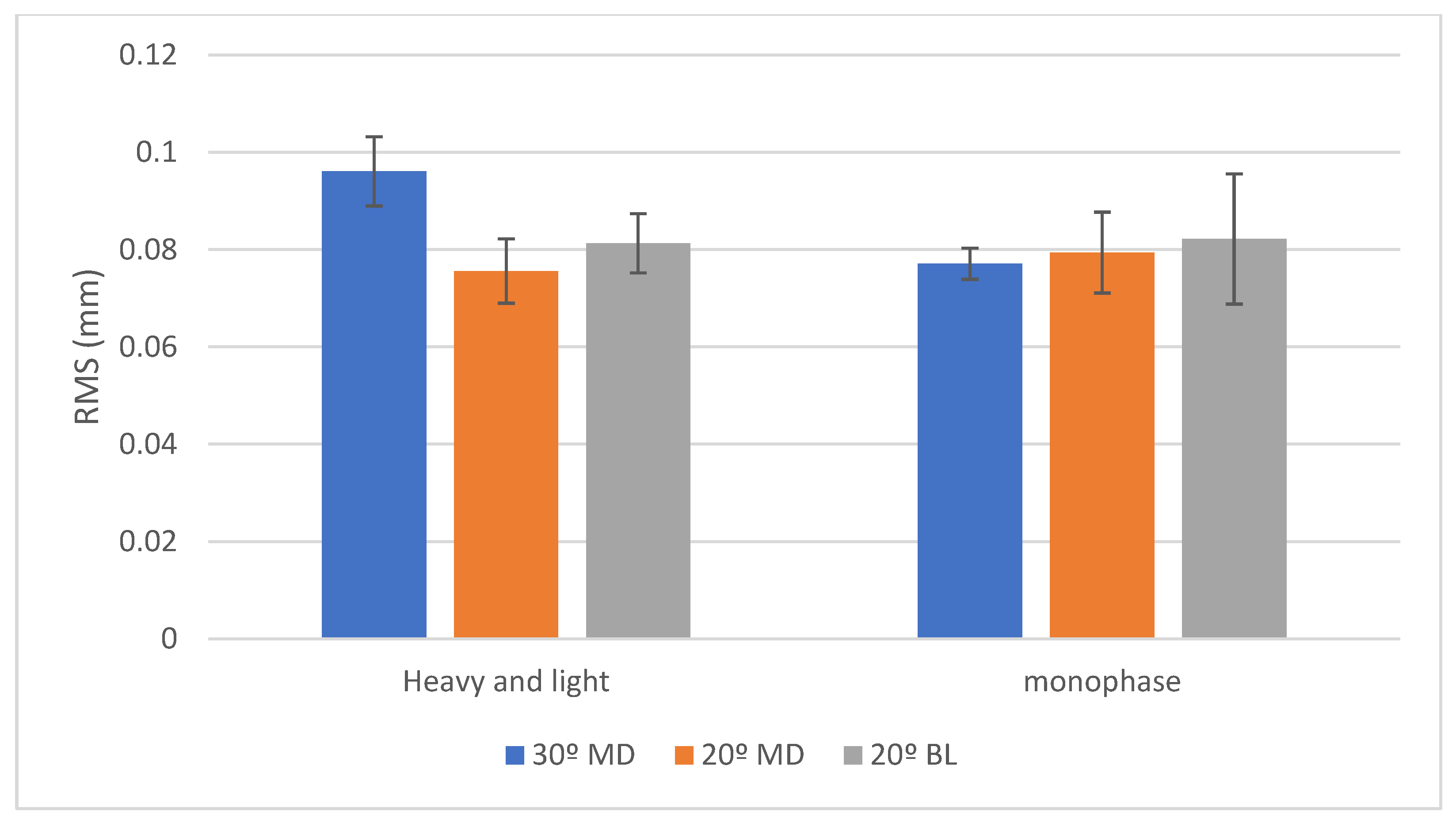Digital Accuracy of Closed-Tray Implant Impressions: Influence of Polyvinyl Siloxane Viscosity and Subgingival Posterior Implant Angulation
Abstract
1. Introduction
2. Materials and Methods
2.1. Ethical Approval
2.2. Sample Size Calculation
2.3. Master Model Preparation
- Model 1: 30° mesiodistal angulation (tilted distally, Group 1: 30° MD).
- Model 2: 20° mesiodistal angulation (tilted distally, Group 2: 20° MD).
- Model 3: 20° buccolingual angulation (converging lingually, Group 3: 20° BL).
2.4. Custom Trays Fabrication
2.5. Impression Procedures
2.6. Cast Fabrication and Scanning
2.7. Accuracy Evaluation and 3D Deviation Analysis
2.8. Statistical Analysis
3. Results
4. Discussion
Limitations and Recommendations
5. Conclusions
- Within the limitations of this in vitro study, both monophase and heavy + light body polyvinyl siloxane (PVS) impressions demonstrated clinically acceptable accuracy.
- The combination of heavy + light body PVS impressions provided enhanced accuracy compared to monophase impressions.
- The superiority of the heavy + light body PVS was most evident in cases with multiple angulated implants, particularly at a 30° distal angulation in sub-gingival positions, when using the closed-tray technique.
- These findings suggest that impression material selection should be carefully considered in challenging clinical scenarios involving angulated implants to optimize accuracy and prosthetic outcomes.
Author Contributions
Funding
Institutional Review Board Statement
Informed Consent Statement
Data Availability Statement
Conflicts of Interest
References
- Taymour, N.; Fahmy, A.E.; Gepreel, M.A.H.; Kandil, S.; El-Fattah, A.A. Improved Mechanical Properties and Bioactivity of Silicate Based Bioceramics Reinforced Poly(Ether-Ether-Ketone) Nanocomposites for Prosthetic Dental Implantology. Polymers 2022, 14, 1632. [Google Scholar] [CrossRef] [PubMed]
- Elsayed, S.; Ahmed, Y.; El-Anwar, M.I.; Elddamony, E.; Ashraf, R. Influence of Different Polymeric Materials of Implant and Attachment on Stress Distribution in Implant-Supported Overdentures: A Three-Dimensional Finite Element Study. BMC Oral Health 2025, 25, 166. [Google Scholar] [CrossRef] [PubMed]
- Moura, R.V.; Kojima, A.N.; Saraceni, C.H.C.; Bassolli, L.; Balducci, I.; Özcan, M.; Mesquita, A.M.M. Evaluation of the Accuracy of Conventional and Digital Impression Techniques for Implant Restorations. J. Prosthodont. 2019, 28, e530–e535. [Google Scholar] [CrossRef] [PubMed]
- Ahmed, Y.; Taha, M.G.M.; Elbelacy, H.; Gaber, M.S.; Fernandes, G.V.O.; Rahhal, M. Radiographic Outcomes Comparing Mini-Implant Versus Conventional Implant-Retained Overdenture with Different Attachment Systems: A Randomized Controlled Clinical Trial. Int. J. Oral Maxillofac. Implant. 2025, 1–21. [Google Scholar] [CrossRef]
- Hassanein, F.E.A.; El Barbary, A.; Hussein, R.R.; Ahmed, Y.; El-Guindy, J.; Sarhan, S.; Abou-Bakr, A. Diagnostic Performance of ChatGPT-4o and DeepSeek-3 Differential Diagnosis of Complex Oral Lesions: A Multimodal Imaging and Case Difficulty Analysis. Oral Dis. 2025, 26, 1255–1264. [Google Scholar] [CrossRef]
- Abou-Bakr, A.; Ahmed, E.; William, H.; Hassanein, F.E.A. Frequency of Periodontal Disease in Head and Neck Cancer Patients after Radiation Therapy: A Cross-Sectional Study. BMC Oral Health 2025, 25, 1008. [Google Scholar] [CrossRef]
- Alikhasi, M.; Siadat, H.; Rahimian, S. The Effect of Implant Angulation on the Transfer Accuracy of External-Connection Implants. Clin. Implant. Dent. Relat. Res. 2015, 17, 822–829. [Google Scholar] [CrossRef]
- Yasar, M.N.; Cetinsahin, C.; Bayar, O.; Ozer, H.Y. Implant Impression Techniques Using Different Materials and Methods: A Review. J. Clin. Diagn. Res. 2022, 16, ZE12–ZE17. [Google Scholar] [CrossRef]
- Taymour, N.; Alabdrubalameer, D.I.; Al Shooq, Z.H.; Al Yaseen, M.S.; Al Zaher, R.H.; Shetty, A.C.; Rifaat, S. Dimensional Accuracy of Polyether Elastomeric Impression Materials After Using Chitosan as a Disinfectant: A Sustainable Approach to Dental Infection Control. Prosthesis 2025, 7, 7. [Google Scholar] [CrossRef]
- Zenthöfer, A.; Rues, S.; Rammelsberg, P.; Ruckes, D.; Stober, T. Accuracy of a New Fast-Setting Polyether Impression Material. Int. J. Prosthodont. 2020, 33, 410–417. [Google Scholar] [CrossRef]
- Nowakowska-Toporowska, A.; Malecka, K.; Raszewski, Z.; Wieckiewicz, W. Changes in Hardness of Addition-Polymerizing Silicone-Resilient Denture Liners After Storage in Artificial Saliva. J. Prosthet. Dent. 2019, 121, 317–321. [Google Scholar] [CrossRef] [PubMed]
- Kahramanoğlu, E.; Aslan, Y.U.; Özkan, Y.; Keskin Özyer, E. İmplant Destekli Protetik Restorasyonlarda Kullanılan Ölçü Yöntemleri ve Materyalleri: Derleme. Eur. J. Res. Dent. 2019, 2, 124–132. [Google Scholar] [CrossRef]
- Parameshwari, G.; Chittaranjan, B.; Sudhirchary, N.; Anulekha Avinash, C.; Taruna, M.; Ramureddy, M. Evaluation of Accuracy of Various Impression Techniques and Impression Materials in Recording Multiple Implants Placed Unilaterally in a Partially Edentulous Mandible—An in Vitro Study. J. Clin. Exp. Dent. 2018, 10, e388–e395. [Google Scholar] [CrossRef] [PubMed]
- Taymour, N.; Abdul Hameed, S.M.; AlGhamdi, M.A.; El Sharkawy, Z.R.; Farid, Z.S.; Ahmed, Y. Accuracy of New-Generation Intraoral Scanners in Digitizing All-on-Four Implant Models with Varying Posterior Implant Angulations: An In Vitro Trueness and Precision Evaluation. Prosthesis 2025, 7, 74. [Google Scholar] [CrossRef]
- Izadi, A.; Heidari, B.; Roshanaei, G.; Allahbakhshi, H.; Fotovat, F. Comparative Study of Dimensional Accuracy in Three Dental Implant Impression Techniques: Open Tray, Closed Tray with Impression Coping, and Snap Cap. J. Contemp. Dent. Pract. 2018, 19, 974–981. [Google Scholar] [CrossRef]
- Önöral, Ö.; Kurtulmus-Yilmaz, S.; Toksoy, D.; Ozan, O. Effect of Angulation on the 3D Trueness of Conventional and Digital Implant Impressions for Multi-Unit Restorations. J. Adv. Prosthodont. 2023, 15, 290. [Google Scholar] [CrossRef]
- Pera, F.; Pesce, P.; Bevilacqua, M.; Setti, P.; Menini, M. Analysis of Different Impression Techniques and Materials on Multiple Implants Through 3-Dimensional Laser Scanner. Implant. Dent. 2016, 25, 232–237. [Google Scholar] [CrossRef]
- Taymour, N.; Hussein Abdel Kader, S.; Aboushelib, M.N.; Gad, M.M. Comparative Analysis of Dimensional Changes in Autoclavable Polyvinyl Siloxane (PVS) Impressions Under Various Sterilization/Disinfection Protocols: A Randomized Controlled Trial. Saudi Dent. J. 2024, 36, 603–609. [Google Scholar] [CrossRef]
- Saini, H.S.; Jain, S.; Kumar, S.; Aggarwal, R.; Choudhary, S.; Reddy, N.K. Evaluating the Effect of Different Impression Techniques and Splinting Methods on the Dimensional Accuracy of Multiple Implant Impressions: An in Vitro Study. J. Contemp. Dent. Pract. 2018, 19, 1005–1012. [Google Scholar]
- V, M.; Chirom, B.; Gunadhar, K.; Priyadarshini, S.; Nongthombam, R.S.; P, M. The Accuracy of Casts Obtained Using Different Impression Techniques and Impression Materials in Combined Parallel and Angulated Implants: An In Vitro Study. Cureus 2024, 16, e59193. [Google Scholar] [CrossRef]
- Martínez-Rus, F.; García, C.; Santamaría, A.; Özcan, M.; Pradíes, G. Accuracy of Definitive Casts Using 4 Implant-Level Impression Techniques in a Scenario of Multi-Implant System with Different Implant Angulations and Subgingival Alignment Levels. Implant. Dent. 2013, 22, 268–276. [Google Scholar] [CrossRef]
- Awad, E.M.; ElSheikh, M.M.; El-Segai, A.A.E.M. Effect of Soft Tissue Thickness on Accuracy of Conventional and Digital Implant Impression Techniques. BMC Oral Health 2024, 24, 1318. [Google Scholar] [CrossRef]
- Rajendran, R.; Chander, N.; Anitha, K.; Muthukumar, B. Dimensional Accuracy of Vinyl Polyether and Polyvinyl Siloxane Impression Materials in Direct Implant Impression Technique for Multiple Dental Implants. Eur. Oral Res. 2021, 55, 54–59. [Google Scholar] [CrossRef]
- Abd El-fattah, F.; Alam-Eldein, A.; Elshenawy, E. Effect of Impression Materials and Techniques on Impressions Accuracy for Angulated Implants. Egypt. Dent. J. 2018, 64, 2501–2511. [Google Scholar] [CrossRef]
- Vojdani, M.; Torabi, K.; Ansarifard, E. Accuracy of Different Impression Materials in Parallel and Nonparallel Implants. Dent. Res. J. 2015, 12, 315. [Google Scholar] [CrossRef]
- Alikhasi, M.; Siadat, H.; Nasirpour, A.; Hasanzade, M. Three-Dimensional Accuracy of Digital Impression versus Conventional Method: Effect of Implant Angulation and Connection Type. Int. J. Dent. 2018, 2018, 3761750. [Google Scholar] [CrossRef] [PubMed]
- Vigolo, P.; Mutinelli, S.; Fonzi, F.; Stellini, E. An In Vitro Evaluation of Impression Techniques for Multiple Internal- and External-Connection Implant Prostheses. Int. J. Oral Maxillofac. Implant. 2014, 29, 807–818. [Google Scholar] [CrossRef] [PubMed]
- Andriessen, F.S.; Rijkens, D.R.; Van Der Meer, W.J.; Wismeijer, D.W. Applicability and Accuracy of an Intraoral Scanner for Scanning Multiple Implants in Edentulous Mandibles: A Pilot Study. J. Prosthet. Dent. 2014, 111, 186–194. [Google Scholar] [CrossRef] [PubMed]
- Dohiem, M.M.; Abdelaziz, M.S.; Abdalla, M.F.; Fawzy, A.M. Digital Assessment of the Accuracy of Implant Impression Techniques in Free End Saddle Partially Edentulous Patients. A Controlled Clinical Trial. BMC Oral Health 2022, 22, 486. [Google Scholar] [CrossRef]
- Farronato, D.; Pasini, P.M.; Campana, V.; Lops, D.; Azzi, L.; Manfredini, M. Can Transfer Type and Implant Angulation Affect Impression Accuracy? A 3D in Vitro Evaluation. Odontology 2021, 109, 884–894. [Google Scholar] [CrossRef]
- Osman, M.S.; Ziada, H.M.; Abubakr, N.H.; Suliman, A.M. Implant Impression Accuracy of Parallel and Non-Parallel Implants: A Comparative In-Vitro Analysis of Open and Closed Tray Techniques. Int. J. Implant. Dent. 2019, 5, 4. [Google Scholar] [CrossRef] [PubMed]
- Robaian, A.; Hamed, M.M.; Ahmed, Y.; Hassanein, F.E.A. Comparative Evaluation of Customized CAD/CAM vs. Stock Titanium Abutments for Immediate Implant Placement in Class II Extraction Sockets: A Randomized Controlled Trial. Dent. J. 2025, 13, 371. [Google Scholar] [CrossRef] [PubMed]
- Linkevicius, T.; Svediene, O.; Vindasiute, E.; Puisys, A.; Linkeviciene, L. The Influence of Implant Placement Depth and Impression Material on the Stability of an Open Tray Impression Coping. J. Prosthet. Dent. 2012, 108, 238–243. [Google Scholar] [CrossRef] [PubMed]
- P. M, G.; Sukumaran, K.; K, H.; Ravindran, S. Evaluation of the Stability of Open-Tray Impression Coping Using Two Different Impression Materials at Three Different Subgingival Implant Placement Depths. Cureus 2024, 16, e61117. [Google Scholar] [CrossRef]
- Kontis, P.; Güth, J.-F.; Keul, C. Accuracy of Full-Arch Digitalization for Partially Edentulous Jaws—A Laboratory Study on Basis of Coordinate-Based Data Analysis. Clin. Oral Investig. 2022, 26, 3651–3662. [Google Scholar] [CrossRef]
- Amin, S.; Weber, H.P.; Finkelman, M.; El Rafie, K.; Kudara, Y.; Papaspyridakos, P. Digital vs. Conventional Full-Arch Implant Impressions: A Comparative Study. Clin. Oral Implant. Res. 2017, 28, 1360–1367. [Google Scholar] [CrossRef]
- Lin, W.-S.; Harris, B.; Elathamna, E.; Abdel-Azim, T.; Morton, D. Effect of Implant Divergence on the Accuracy of Definitive Casts Created from Traditional and Digital Implant-Level Impressions: An In Vitro Comparative Study. Int. J. Oral Maxillofac. Implant. 2015, 30, 102–109. [Google Scholar] [CrossRef]
- Conrad, H.J.; Pesun, I.J.; DeLong, R.; Hodges, J.S. Accuracy of Two Impression Techniques with Angulated Implants. J. Prosthet. Dent. 2007, 97, 349–356. [Google Scholar] [CrossRef]
- Richi, M.W.; Kurtulmus-Yilmaz, S.; Ozan, O. Comparison of the Accuracy of Different Impression Procedures in Case of Multiple and Angulated Implants: Accuracy of Impressions in Multiple and Angulated Implants. Head Face Med. 2020, 16, 9. [Google Scholar] [CrossRef]
- Ghahremanloo, A.; Seifi, M.; Ghanbarzade, J.; Abrisham, S.M.; Javan, R.A. Effect of Polyvinyl Siloxane Viscosity on Accuracy of Dental Implant Impressions. J. Dent. 2017, 14, 40–47. [Google Scholar]
- Aidasani, A.N.; Jain, S.; Hassan, S.; Sharma, A.; Shanthi, C.; Fere, S. Comparative Evaluation of the Rigidity and Accuracy of Different Elastomeric Impression Materials with Open Tray Implant Level Impression Technique—An In Vitro Study. J. Pharm. Bioallied Sci. 2023, 15, S1262–S1265. [Google Scholar] [CrossRef] [PubMed]
- Shim, J.S.; Ryu, J.J.; Shin, S.W.; Lee, J.Y. Effects of Implant Angulation and Impression Coping Type on the Dimensional Accuracy of Impressions. Implant. Dent. 2015, 24, 726–729. [Google Scholar] [CrossRef] [PubMed]
- Papaspyridakos, P.; Chen, C.-J.; Gallucci, G.; Doukoudakis, A.; Weber, H.-P.; Chronopoulos, V. Accuracy of Implant Impressions for Partially and Completely Edentulous Patients: A Systematic Review. Int. J. Oral Maxillofac. Implant. 2014, 29, 836–845. [Google Scholar] [CrossRef] [PubMed]
- Lyu, M.; Di, P.; Lin, Y.; Jiang, X. Accuracy of Impressions for Multiple Implants: A Comparative Study of Digital and Conventional Techniques. J. Prosthet. Dent. 2022, 128, 1017–1023. [Google Scholar] [CrossRef]
- Elshenawy, E.A.; Alam-Eldein, A.M.; Abd Elfatah, F.A. Cast Accuracy Obtained from Different Impression Techniques at Different Implant Angulations (In Vitro Study). Int. J. Implant. Dent. 2018, 4, 9. [Google Scholar] [CrossRef]
- Filho, H.G.; Mazaro, J.V.Q.; Vedovatto, E.; Assunção, W.G.; Santos, P.H.D. Accuracy of Impression Techniques for Impants. Part 2—Comparison of Splinting Techniques. J. Prosthodont. 2009, 18, 172–176. [Google Scholar] [CrossRef]
- Sorrentino, R.; Gherlone, E.F.; Calesini, G.; Zarone, F. Effect of Implant Angulation, Connection Length, and Impression Material on the Dimensional Accuracy of Implant Impressions: An In Vitro Comparative Study. Clin. Implant. Dent. Relat. Res. 2010, 12, e63–e76. [Google Scholar] [CrossRef]
- Baldissara, P.; Koci, B.; Messias, A.M.; Meneghello, R.; Ghelli, F.; Gatto, M.R.; Ciocca, L. Assessment of Impression Material Accuracy in Complete-Arch Restorations on Four Implants. J. Prosthet. Dent. 2021, 126, 763–771. [Google Scholar] [CrossRef]
- D’Albis, G.; D’Albis, V.; Susca, B.; Palma, M.; Al Krenawi, N. Implant-Supported Zirconia Fixed Partial Dentures Cantilevered in the Lateral-Posterior Area: A 4-Year Clinical Results. J. Dent. Res. Dent. Clin. Dent. Prospect. 2022, 16, 258–263. [Google Scholar] [CrossRef]




| Material/Equipment | Manufacturer (Country) | Model/Reference Number |
|---|---|---|
| Transparent epoxy resin | CMB International, Egypt | BN1443120720 E667 G |
| Autopolymerizing resin | Acrostone Dental Manufacturer, Egypt | |
| Universal Tray Adhesive | Zhermack, Badia Polesine, Italy | C700025 |
| PVS (Heavy + Light Body)—Elite HD+ | Zhermack, Badia Polesine, Italy | C202032 C203040 |
| PVS (Monophase)—Hydrorise Monophase | Zhermack, Badia Polesine, Italy | C207007 |
| Mixing syringe & dispensing gun | DENTP, China | |
| Type IV dental stone—Fujirock EP | GC Corp., Tokyo, Japan | 890222 |
| PEEK scan adapters | Implant Direct, Sybron International, USA | #8035-09 |
| Internal connection implant analogues | Implant Direct, Sybron International, USA | Legacy 1™ Internal Analogue. #8035-06 |
| Impression coping | Implant Direct, Sybron International, USA | Closed tray, implant level transfer #8035-05 |
| 5-axis CNC machine | YCM Fanuc, Yeong Chin Machinery Ltd., Taiwan | YCM-Fanuc 5X |
| Laboratory scanner—Activity 885 | Smart Optics, Germany | Activity 885 |
| Reverse engineering software | 3D Systems, USA | Geomagic Control X (2022) |
| Source of Variation | Type III Sum of Squares | df | Mean Square | F-Value | p-Value | Effect Size (Partial Eta Squared) | 95% CI for η2 |
|---|---|---|---|---|---|---|---|
| Angulation | 0.001 | 2 | 0.0005 | 3.864 | 0.032 * | 0.205 | 0.02–0.39 |
| Impression material | 0.0002 | 1 | 0.0002 | 3.115 | 0.088 | 0.094 | 0.00–0.27 |
| Angulation × Impression material interaction | 0.001 | 2 | 0.0005 | 7.12 | 0.003 * | 0.322 | 0.08–0.49 |
| Variables | Mean | SD | p-Value | Effect Size (Partial Eta Squared) | 95% CI for η2 | |
|---|---|---|---|---|---|---|
| Angulation | 30° MD | 0.0866 A | 0.0112 | 0.032 * | 0.205 | |
| 20° MD | 0.0775 B | 0.0074 | 0.02–0.39 | |||
| 20° BL | 0.0817 AB | 0.0099 | ||||
| Impression material | monophase | 0.0843 | 0.0108 | 0.088 | 0.094 | 0.00–0.27 |
| Heavy + light | 0.0796 | 0.009 | ||||
| Impression Material | 30° MD | 20° MD | 20° BL | p-Value | Effect Size (Partial Eta Squared) | 95% CI for η2 | |||
|---|---|---|---|---|---|---|---|---|---|
| Mean | SD | Mean | SD | Mean | SD | ||||
| Monophase | 0.0961 A | 0.0071 | 0.0756 C | 0.0066 | 0.0813 B | 0.0061 | <0.001 * | 0.409 | 0.19–0.55 |
| Heavy + light | 0.0771 | 0.0032 | 0.0794 | 0.0083 | 0.0822 | 0.0134 | 0.550 | 0.039 | 0.00–0.17 |
| p-value | <0.001 * | 0.420 | 0.839 | ||||||
| Effect size (Partial eta squared) | 0.357 | 0.022 | 0.001 | ||||||
| 95% CI for η2 | 0.11–0.49 | 0.00–0.15 | 0.00–0.09 | ||||||
Disclaimer/Publisher’s Note: The statements, opinions and data contained in all publications are solely those of the individual author(s) and contributor(s) and not of MDPI and/or the editor(s). MDPI and/or the editor(s) disclaim responsibility for any injury to people or property resulting from any ideas, methods, instructions or products referred to in the content. |
© 2025 by the authors. Licensee MDPI, Basel, Switzerland. This article is an open access article distributed under the terms and conditions of the Creative Commons Attribution (CC BY) license (https://creativecommons.org/licenses/by/4.0/).
Share and Cite
Ahmed, Y.; Hameed, S.M.A.; Sharkawy, Z.R.E.; Alshahrani, F.A.; Mahmoud, T.A.; M. Mohamed, I.; Taymour, N. Digital Accuracy of Closed-Tray Implant Impressions: Influence of Polyvinyl Siloxane Viscosity and Subgingival Posterior Implant Angulation. Dent. J. 2025, 13, 421. https://doi.org/10.3390/dj13090421
Ahmed Y, Hameed SMA, Sharkawy ZRE, Alshahrani FA, Mahmoud TA, M. Mohamed I, Taymour N. Digital Accuracy of Closed-Tray Implant Impressions: Influence of Polyvinyl Siloxane Viscosity and Subgingival Posterior Implant Angulation. Dentistry Journal. 2025; 13(9):421. https://doi.org/10.3390/dj13090421
Chicago/Turabian StyleAhmed, Yousra, Shereen Moselhy Abdul Hameed, Zainab Refaey El Sharkawy, Faris A. Alshahrani, Tarek AbdAllah Mahmoud, Inas M. Mohamed, and Noha Taymour. 2025. "Digital Accuracy of Closed-Tray Implant Impressions: Influence of Polyvinyl Siloxane Viscosity and Subgingival Posterior Implant Angulation" Dentistry Journal 13, no. 9: 421. https://doi.org/10.3390/dj13090421
APA StyleAhmed, Y., Hameed, S. M. A., Sharkawy, Z. R. E., Alshahrani, F. A., Mahmoud, T. A., M. Mohamed, I., & Taymour, N. (2025). Digital Accuracy of Closed-Tray Implant Impressions: Influence of Polyvinyl Siloxane Viscosity and Subgingival Posterior Implant Angulation. Dentistry Journal, 13(9), 421. https://doi.org/10.3390/dj13090421







